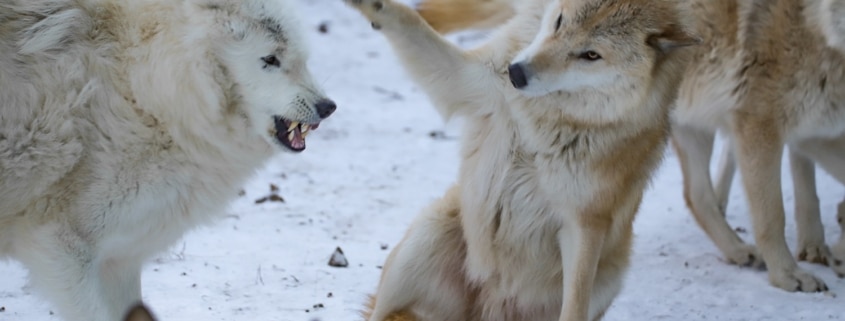Exhibit Pack Update – 18 December 2023
For this week’s Pack Update, we wanted to focus on wolf communication. Here at the International Wolf Center, we see examples of wolf communication every single day. Wolves may communicate through vocalizations, behaviors, scent, body posture (including ear and tail position), and facial expression. This week’s YouTube Update features some examples of canid communication. While watching you will hear a dog barking. For dogs, a bark is usually nothing too serious; it may be used to express excitement, to get a human’s attention, or as a territorial display. A bark in wolf pack is quite a bit more serious; wolves may bark as an alarm signal or as a threat display. This is an excellent example of how wolves and dogs can differ in communication.
We continue to see increased social behavior between Rieka and Grayson, both wolves communicating with invite chases, high tail wags, and muzzle licks. We also often hear quite a bit of vocal communication between yearling littermates, Caz and Blackstone. While this may sound noisy at times, it’s important to remember that vocalizations such as growling do not inherently signify aggression or violence. Canids may growl as a sign for another wolf to back off and is often used to set boundaries between individuals. It is a useful tool in canid communication (especially during ritualized dominance) and may even prevent larger conflict in the long run.
A common theme we try to emphasize is that there are no bad or good behaviors; they are simply wolves being wolves.
We have also had some recent enclosure additions and updates for the Exhibit Pack. Two additional cameras have been added to our surveillance system, allowing for us to better monitor our wolf ambassadors and the facility grounds. Our cameras on Explore.org have also been serviced; the North Cam now has sound again and the South Cam has been replaced with a newer camera. Some rock work was done to the back den to prevent flooding next spring. Rock steps were added by the Boltz Byway medical pen to provide an easier way for wolves to enter and exit the kennel space.




